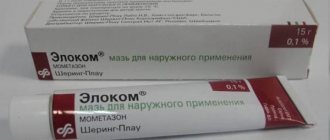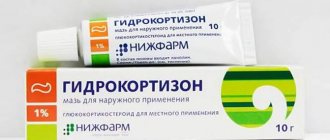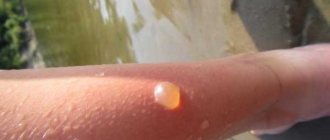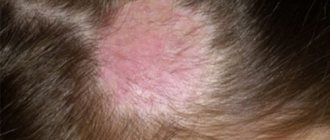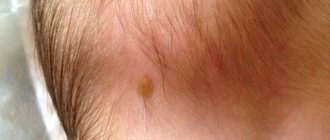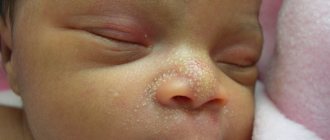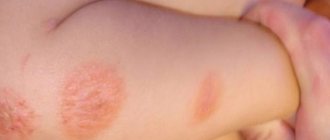Bathing a child with dermatitis
Until recently, doctors recommended avoiding frequent water treatments for dermatitis. What does medicine say today, is it possible to bathe a child with dermatitis and how often should it be done?
There are many recipes for baths and rinses that will help with various forms of this disease. Let's highlight some of them and consider what to bathe a child with atopic dermatitis and allergic dermatous rashes.
We will talk about infants, since this age category is most sensitive to the effects of various drugs and herbal elements.
Allergic dermatitis
Allergy sufferers can swim; the moisture is not harmful to sore skin. The problem often occurs due to chlorine found in tap water. City residents are forced to put up with this, since they simply have no other options.
But is it possible to bathe a child with dermatitis that occurs due to allergic reactions?
In order not to aggravate the irritation of the baby’s skin, parents will have to work hard. Water settling or cleaning filters will help reduce the alkaline environment.
Parents often wonder whether it is possible to bathe a child with allergic dermatitis with special products and herbal decoctions, and which ones exactly?
- Note that if you have an allergy, you need to use any new product very carefully, especially of synthetic or plant origin.
- When using any remedy for the first time, you need to wait two days and look at the reaction of the child’s body.
Traditional methods
Photo: oak bark and leaves
Traditional medicine advises bathing a child with allergic dermatitis using the following means:
- Freshly brewed black tea.
- Decoction of bay leaf.
- Decoction of oak bark.
- Infusion of wheat bran or oats (for dry skin).
- A decoction of string, chamomile, mint (for weeping or oily skin).
The last of these recipes can itself cause allergies, so you need to be very careful when using it to bathe a baby with allergies.
It is better to brew the ingredients one at a time rather than making a decoction from all of them at once. You may have an allergic reaction to only one of them.
That is why it is not recommended to bathe a child with allergic dermatitis with a decoction of a special anti-allergic mixture, which is sold in a pharmacy.
Atopic dermatitis
Photo: birch leaves and buds
If you have diaper dermatitis, you definitely need to bathe, and the more, the better.
But when the disease becomes atopic, many parents begin to wonder whether their baby needs water treatments and what to use in the bath.
This is what traditional medicine suggests to bathe a child with atopic dermatitis in:
- Birch buds and leaves. Take 200 grams of birch leaves and buds and pour 1 liter of boiling water. Leave for 3 hours. After filtering, the broth is added to the bath.
- Sea salt. It can be bought at a pharmacy. Add to the bath and stir until completely dissolved in water.
- Starch. Dissolve starch powder (3 tablespoons) in 1 liter of boiled water. Stir thoroughly and add to the bath.
- Milk and olive oil. This recipe for what to bathe a baby with atopic dermatitis can be used by adults, not only with diseased skin, but also with healthy skin. It's called "Cleopatra's secret." Mix 1 liter of milk and 100 grams of unrefined olive oil, you can slightly heat the product to 40 degrees. Add the resulting substance to the bath. Take 15-20 minutes.
Is it possible to bathe a child with atopic dermatitis with herbal ingredients?
Yes, it is possible, even necessary, but each of the herbal products, as with allergic dermatitis, should be checked for individual intolerance.
Traditional healers advise bathing a baby with atopic dermatitis with the addition of herbal decoctions:
- Celandine.
- Sequences.
- Violets.
- Nettles.
- Burdock root.
What do doctors suggest to bathe children with atopic dermatitis in? Today, special bath products are produced for babies.
If you cannot swim during severe exacerbations or purulent inflammations, use compresses with thermal water of Aven, La Roche-Posay.
The skin can be cleansed with Sensibio H2O Bioderma. A series of medicines have been developed that are called: bath gels, bath oils, and so on.
Photo: Sensibio H2O bioderma
Among the most well-known products that can be used to bathe children with atopic dermatitis are the following:
- Trixer's bath.
- Bath additive A-derma.
- Bath oil Mustela Stelatoria.
For washing, use only special soap. A well-proven baby detergent with cold cream, which contains:
- beeswax,
- almond oil extract,
- paraffin base,
- rose water.
Thus, you can bathe a child with dermatitis; without serious reasons, you should not deprive your baby of such pleasure.
Some advice for parents
A prerequisite for bathing a baby with allergies or atopic dermatitis is compliance with the temperature regime.
The water should be warm, even cool: 36 – 37.5 degrees. The hardening technique has proven its effectiveness.
During water procedures using cold water (room temperature), the skin of babies quickly cleared, but the baby must be accustomed to such water gradually.
Let's talk about how to bathe a child with atopic dermatitis or allergies:
- The baby needs to be immersed in water for 10-15 minutes.
- This should be done gradually so as not to frighten the baby with a new sensation.
- Do not use typical baby washes, only the special ones mentioned above.
- Do not stretch or rub the skin.
Only soft touches should be used. After the bath, pat the baby dry with a towel and leave undressed for 7-10 minutes to receive air treatments. After this, apply special care products to the skin.
[Total votes: 2 Average: 3/5]
thepsorias.ru
Features of the disease
Many who have suffered from this disease do not know whether it is possible to wash themselves if they have hives. The answer is clear - yes, you can wash yourself if you have hives. You just need to do this carefully, because the itching can intensify and spread to other areas of the skin. You should bathe in a bath where the water temperature does not reach above 37 degrees. You should also not douse yourself with cold water. You need to take a shower (not to be confused with a bath) every day.
We invite you to familiarize yourself with Flaxseed oil for hair: 20 recipes for masks for growth, hair loss and ends, as well as the benefits, how to properly apply and rinse off the oil
It is not advisable to use washcloths and rub the reddened areas even more. Do not use detergents that have a strong odor. It's better to just use plain water. If you decide to use soap, gel or shampoo, it is best to test it in advance before bathing.
Apply the cleanser you want to test on a small area of skin. Doctors recommend not swimming for more than 10-15 minutes. After a shower, you need to pat your wet skin as gently as possible with a dry towel, but do not rub it. Afterwards it is advisable to use baby cream. Its use is important to moisturize the skin, relieve dryness and prevent itching.
If you have hives, you can shower without using a washcloth.
Cold urticaria can last for several years. Statistics show that in every third clinical case, the symptoms of the disease are completely resolved only after 5-8 years.
Experiment with a piece of ice and hives
If the human body begins to react atypically to exposure to low temperatures, cold allergies can be identified by symptoms.
Herbal decoctions for bathing infants
In many families, bathing a baby is a nightly ritual that helps the baby not only adapt to environmental conditions (this is how the baby hardens), but also relax before bed. Until the umbilical wound heals, it is recommended to bathe the child in boiled water with a weak solution of potassium permanganate, and when the wound heals, herbs are added to the water for bathing newborns. Since our great-grandmothers bathed babies in herbs, many mothers automatically repeat this algorithm. Chamomile and celandine recommended by pediatricians are commonly used, although there are about 30 types of herbs suitable for bathing babies.
The benefits of herbal baths for a newborn and the rules for their use
A newborn's skin is very delicate and is easily exposed to irritants in the early stages of life.
- No matter how closely the parents monitor the baby, in the heat the baby often develops prickly heat.
- Diaper rash in numerous folds becomes a disaster for large babies.
- A mother's favorite product may cause rashes in a breastfed baby
Herbal baths not only help get rid of these problems, but also have a relaxing or tonic effect with increased or decreased tone. In addition, bathing in herbs has a calming effect on the baby’s nervous system - this is very important for children with increased nervous excitability. It is important to remember that a positive result can only be achieved with the correct selection of herbs and their correct use.
Adults are often wary of factory-made children's cosmetics, rightly assuming that these products can harm the child (dry skin, cause allergies, etc.), so they use children's shampoos and creams with caution. Herbs as traditional medicine are often considered absolutely harmless. However, using herbs to bathe a baby also requires precautions - each herb has its own medicinal properties and may be contraindicated for a particular child. In addition, even harmless herbs that are actively used in medicine (for example, chamomile) can also cause allergies. In order for herbal baths to bring only benefits, you need to take into account simple rules:
Important!
Doctors are dumbfounded! EXCESS weight after childbirth goes away forever! An effective and inexpensive means for safe weight loss...Read more >>
- You should not experiment and make multi-component decoctions without a doctor’s prescription - the components may have mutually exclusive properties, and in case of allergic reactions it will be difficult for you to determine the “culprit”
- Before the first bath in water with a decoction, you need to soak a piece of cotton wool in the decoction and moisten a small area of the baby’s skin. If redness or rash does not appear within 15 minutes, the baby can be dipped in a bath with a decoction. If any changes are noticeable, this herb should be excluded.
- Herbs that are used for bathing babies should only be purchased at a pharmacy - you can collect the herbs yourself only in an ecologically clean area. For the same reason, you cannot buy herbal infusions from your own hands - you cannot find out exactly where this herb was collected
- If you purchased filter bags, you will need 5 bags per one and a half liters of hot water to bathe your baby. Dried herb allows you to make a more concentrated decoction (as a result, you get more of it) - only a handful of herb is used for 5 liters of water. The decoction is infused for about an hour before use (maximum time - 5 hours)
- Before bathing the baby, strain the broth using gauze so that leaves and other particles do not end up in the bath
- The weight of the decoction per bath for a baby should not exceed 30 g - a more concentrated solution can cause allergies
- If you decide to use a herbal mixture for bathing your toddler, the components should be taken 1:1. The collection can be used only when there is one hundred percent confidence that the baby is not allergic to all its components
- The decoction is infused in an enamel or earthenware container. It is prohibited to use aluminum products, since this metal reacts with the decoction
- For bathing infants, only fresh broth is used.
Herbs for healthy skin
Herbs that are used for bathing healthy babies:
- Chamomile, which exhibits antibacterial and anti-inflammatory properties and relieves skin irritations. It has a mild calming effect on the central nervous system, helps cope with insomnia and the negative effects of stress. Can be added to the water when bathing a baby suffering from allergic rashes (provided that the baby does not have an allergic reaction to the chamomile itself)
- A series used to treat various skin diseases. It is recommended for bathing healthy babies, as it effectively eliminates yellow seborrheic crusts on the head of a newborn, which often occurs in children in the first months of life. It is advisable to bathe in the herb no more than twice a week, as this herb dries out the baby’s delicate skin
- Nettle, which has an anti-inflammatory and restorative effect, softens and tones the skin, heals wounds and ulcers. This plant has a positive effect on hair growth
- For skin irritations (heat rash, allergies, diaper rash), baths with oak bark are recommended - thanks to the tannins contained in oak bark, tissue irritation is prevented and a kind of protective barrier is formed. Oak bark has antioxidant and antimicrobial properties. You can also use a decoction of bay laurel - it is used for suppuration, allergic rashes and has a calming and disinfecting property.
- For diathesis, atopic dermatitis and pyoderma, baths with St. John's wort are recommended, which also promotes rapid restoration of the skin.
Herbs for colic
Since almost all newborns suffer from colic, to eliminate this problem you can add to the bath:
- Bearberry, which relieves muscle tension and contains tannins that have a strengthening effect on the intestines. This plant also has antiviral, antibacterial and anti-inflammatory properties.
- Hop cones, which have been used since ancient times for disorders of the gastrointestinal tract and have an antispasmodic, relaxing, analgesic and anti-inflammatory effect
- Motherwort has antispasmodic properties and regulates intestinal function. Also has a calming effect
Calming herbs
Calming herbs and sedatives are used for bathing newborns if children are overexcited, sleep restlessly, or the child has a shifted circadian cycle. For soothing baths we recommend:
- Lavender has not only soothing and antispasmodic, but also antiseptic properties. Also effective for flatulence and various rashes
- Valerian, which reduces the excitability of the nervous system. In addition, valerian promotes the healing of skin lesions, relieves spasms, improves the functioning of the gastrointestinal tract and cardiovascular system
- Peppermint has a calming, anti-inflammatory and analgesic effect. Mint also helps increase appetite
- Oregano is often recommended by neurologists for various disorders of the nervous system as an excellent sedative. Oregano relieves pain of various origins, has a good effect on the gastrointestinal tract, and is recommended for rickets and exudative diathesis
For children with allergies, oregano and mint are not recommended as herbs that are potential allergens.
Herbs for hypertension
For hypertonicity, herbs for bathing a newborn are used in the form of mixtures. You can use sedative collection No. 2, containing motherwort herb, peppermint leaves, rhizomes and roots of valerian, licorice roots and hop cones. On the recommendation of a neurologist, knotweed can be included in the collection.
You can add a few drops of fir oil to a decoction of valerian and hop cones (1:1). Children's sea salt with chamomile and, after consultation with a neurologist, pine extract are also used.
Herbs for hypotension
For hypotension, baths with pine extract or a decoction of walnut leaves are recommended (also used for dystonia). Euphorbia, which has a strengthening effect on muscles, is not recommended for small children to add to water, as it is poisonous. For bathing newborns, you can use fees containing:
- string, chamomile, thyme and oats
- nettle, string and oregano
- birch and currant leaves
- nettle, lungwort, horsetail, thyme or oats
The collection is an excellent substitute for ready-made extracts:
- chamomile-lavender-sage;
- chamomile with lemon balm oil;
- string with lavender oil;
- pine extract with thyme and fir oils, etc.
Ready-made extracts are not only easier to use, they are more balanced in composition and therefore more effective. To obtain the concentration required for the baby, all extracts are used exclusively according to the instructions.
Pay attention to the video in which an experienced mother shares tips on bathing her baby in herbal infusions
How to lose weight after childbirth?
Many women after childbirth face the problem of excess weight. For some, it appears during pregnancy, for others, after childbirth.
- And now you can no longer afford to wear open swimsuits and short shorts...
- You begin to forget those moments when men complimented your flawless figure...
- Every time you approach the mirror, it seems to you that the old days will never return...
But there is an effective remedy for excess weight! Follow the link and find out how Anna lost 24 kg in 2 months.
How to lose weight after childbirth?
Many women after childbirth face the problem of excess weight. For some, it appears during pregnancy, for others, after childbirth.
- And now you can no longer afford to wear open swimsuits and short shorts...
- You begin to forget those moments when men complimented your flawless figure...
- Every time you approach the mirror, it seems to you that the old days will never return...
But there is an effective remedy for excess weight! Follow the link and find out how Anna lost 24 kg in 2 months.
Similar articles
ogrudnichke.ru
When should you not take a bath if you are sick?
Adults cannot always take a bath. They are not permitted in cases where there are pustules (under no circumstances!). Since urticaria causes inflammatory processes to form on the epithelial tissue, an excellent environment arises in which harmful microorganisms multiply well and quickly.
Once the bacterium gets on the skin, it will begin to contribute to the development of pustules. In such cases, taking a bath is highly discouraged because it is possible that the entire infection can quickly spread from one area throughout the body.
If you fit this description, it's best to just take a shower every now and then. And the areas of epithelial tissue where pus is located should be washed with a special washcloth (which will not be used for other parts of the body!), or not used at all.
Human hygiene for urticaria: simple rules for bathing
People prone to allergic reactions are often worried about the question: is it possible to wash if you have hives? It can be so nice to plunge into warm water and soothe itchy areas of the body. There is no need to deprive yourself of this pleasure, and it is recommended to take water procedures for hives, following simple rules.
Before you start reading the article, read the advice of an allergist on how to get rid of allergies to flowers. Find out more... »
What is urticaria?
Urticaria is a skin disease, most often of an allergic nature. It manifests itself as the appearance of flat, but slightly protruding above the surface of the skin, reddish, very itchy spots, similar to the skin reaction to a nettle burn. These rashes can appear on the skin of any part of the body: legs, arms, stomach, back, etc.
Sometimes blisters unite and are located over a large surface area of the body. Itchy spots can last on the skin from a couple of minutes to several hours. After the redness disappears, the skin does not undergo any changes - there is no itching or peeling.
Mechanism of the disease
With increased permeability of vessel walls and dilation of capillaries, a significant amount of histamine, a mediator of allergic reactions, is released into the blood. Clusters of blisters appear on the surface of the skin. This is how the body reacts to an external stimulus. They can be physical, chemical, mechanical, pharmacological factors.
Classification of urticaria
- acute – the disease is transient, exacerbation lasts no longer than 6 weeks;
- chronic – long-term form, over 6 weeks;
- urticarial vasculitis is a unique form of the disease. It is characterized by symptoms of contact dermatitis lasting longer than a day. At the same time, inflammation of the capillaries of the skin occurs.
An acute form of skin dermatitis occurs in 20–25% of people. Depending on the reasons for its appearance, there are:
For the prevention and treatment of allergies, our readers recommend: Allergonix drug for the treatment of allergies. A unique natural preparation - the latest development of modern science. The drug "Allergonix" has two effects:
- Preventive – strengthens the immune system, relieves tumors, neutralizes pain in the head, stomach and ENT organs.
- Cosmetic - removes redness from the skin, relieves the effect of hives, helps clear the airways and, as a result, can seriously improve your well-being.
- thermal urticaria - from interaction with high temperatures;
- cold - after contact with cold objects;
- solar – from exposure to the skin of the sun’s rays;
- vibration urticaria - from the influence of vibration;
- dermographic – when scratching the skin;
- cholinergic – rashes after exercise;
- delayed pressure-induced urticaria - after prolonged mechanical pressure on some area of the skin.
Suitable for adults and children, convenient to use at work, home and school! The drug has been clinically tested and approved by the Ministry of Health of Russia, the USA, and Israel. Doctors' opinion..."
Rules for bathing with urticaria
Before swimming, people with a skin condition need to get an accurate diagnosis, their own or, if necessary, a child's, from their doctor. To do this, it is necessary to find out the causes of dermatitis. If allergic dermatitis occurs, you need to wash yourself: take a shower at least 1-2 times a day and relax in the bath at least once a week.
- The first thing you need to worry about is the cleanliness of the bath. It is not enough to wash its walls with detergents. Care must be taken to ensure that any remaining cleaner is completely washed off with water.
- To prevent a possible increase in itching and its spread to healthy areas of the skin, it is necessary to strictly observe the temperature regime when taking water procedures. Its optimal value is considered to be 37–38 degrees. Contact with ice and hot water is best avoided.
- Bathing for urticaria should not exceed 20 minutes. In this case, a shower is preferable, since parts of the body are not constantly in water.
- During an exacerbation of the disease, you will have to give up detergents with a strong smell. These are the most allergenic foods and can aggravate urticaria in adults and children. It is better to use baby soap or cosmetics with a neutral pH level of 5.5.
- Do not use harsh washcloths or scrubs on skin damaged by contact dermatitis.
- If you are not allergic to plants, it is effective to bathe in a decoction of herbs. St. John's wort, string, celandine or chamomile have a beneficial effect on skin affected by rashes. Nettle effectively fights the disease of the same name: you need to take a broom and a decoction from the plant to the bathhouse.
- You need to go to the bathhouse with hives carefully, avoiding hypothermia in case of cold allergies and mechanical influences in case of any types of allergic dermatitis.
- After water procedures, you should not wipe your skin dry with a towel, thereby irritating it again. It will be enough to gently blot it. Then apply a moisturizing or nourishing cream that will protect the skin from excessive moisture loss and soothe itching.
- Bathing a child must adhere to the same rules: bath hygiene, temperature and time conditions, use of detergents and cosmetics, wiping after the procedure.
- Swimming in the sea with hives is not prohibited. Salt water helps soothe irritations, relieves itching, and reduces the number of rashes until they disappear completely.
Treatment of urticaria
To successfully eliminate the symptoms of the disease, it is recommended to adhere to a hypoallergenic diet. It is based on avoiding coffee, nuts, honey, chocolate, fish products, spices and food dyes - the strongest provocateurs of urticaria.
Eliminating the causes is the main way to combat the disease. In many cases, the disease immediately recedes. No drug treatment is required.
The use of ointments and antiallergic drugs gives only a temporary effect, but does not cure the symptoms.
During the acute course of urticaria, it is usually sufficient to use antihistamines and preventive measures.
Chronic urticaria requires more informed treatment. To do this, you must consult a doctor.
Traditional medicine is used to treat urticaria:
- infusions of celery, mint, marjoram, mistletoe, hops;
- decoctions of juniper, oak bark, flax seeds, elderberries, walnut leaves for dousing and preparing baths and lotions.
But perhaps it would be more correct to treat not the effect, but the cause?
We recommend reading the advice of an expert, an allergist, on how to get rid of allergies to flowers... Read the article allrg.ru
The main signs of urticaria
It all starts with blistering-like rashes on the skin with a red tint. This rash can appear on absolutely any part of the body: legs, stomach, arms, back, face, and so on. The rash may be scattered throughout the affected area of skin in small specks. There are times when small blisters join together to create one large red spot. The itching is very strong, and its intensity increases each time and the person can no longer stop scratching the area of infection.
We suggest you familiarize yourself with Itchy clitoris: causes, treatment, disease prevention
Urticaria is different in that after the acute period of the allergic reaction passes, not a single scar, mark or scar remains in place of the blisters. Everything heals on its own.
Urticaria appears in the form of uneven blisters.
Is it possible to swim if you have allergies | Pharmacy in the House
Allergies of any nature bring many problems to their owners. People suffering from allergic reactions have to give up many things. Do not eat certain foods, do not wear your favorite clothes made of wool and synthetic fabrics, do not have pets, do not enjoy a bouquet of flowers, and much more. Among all the similar restrictions that an allergic person subjects himself to, there are some that at first glance have a basis, but in reality it turns out that not everything is so serious. One of these issues is bathing. Of course, no one will completely abandon water procedures, but you should listen to some advice from allergists.
And doctors refute the opinion that swimming with allergic manifestations on the skin is harmful. Cleanliness can't hurt. There are situations when for some time it is worth almost completely abandoning the shower or bath, not to mention natural water sources, but allergies in most cases do not apply to these contraindications.
Swimming for allergies
Skin rashes that accompany some types of allergies respond to water treatments by increasing itching and spreading to other areas of the body. In order to avoid this, you must adhere to a certain temperature regime - about 37 degrees. In addition, during an exacerbation of the disease, you should stop using washcloths, scrubs and other irritating agents. A warm, refreshing shower for an allergy sufferer is much preferable to a hot, relaxing bath. If there is a need to take water procedures in the bathroom, then it is better to reduce the time spent in the water to 15-20 minutes. The skin should not be rubbed under any circumstances. After bathing, carefully dry it with a soft towel and lubricate it with a moisturizing or nourishing cream.
Many parents of children with allergies prefer to bathe their children in a decoction of medicinal herbs. Reasonable use of folk remedies helps to cope with external manifestations of allergies, relieves itching, etc. But it is necessary to consult a specialist before using any product. However, if you overdo it with this type of bathing, you can seriously dry out the skin and give your child an allergy to some completely harmless herb. It is important to thoroughly clean the bathtub before bathing a child with allergies, since detergents remaining on its walls can only intensify the manifestations of allergies. However, you should not use potassium permanganate. It is necessary only until the umbilical wound heals.
Naturally, all detergents used when bathing an allergy sufferer of any age must be hypoallergenic, without fragrances, dyes, etc. Having chosen a shower gel or shampoo that does not cause skin irritation, you should use only them after testing them on a small area of the skin. Diversity is inappropriate in this case. Nowadays, products with antimicrobial and anti-inflammatory effects are widely available on the market. It is better to coordinate their choice with your doctor. It is advisable to limit yourself to weekly bathing with detergents during a relapse of the disease. The rest of the time, it is best to wash with plain water, using soap only for the most contaminated areas. If you neglect water procedures, thinking that this will help cope with the manifestations of allergies, then you can only aggravate the course of the disease. Various bacteria quickly multiply on dirty skin, which in no way alleviates the patient’s condition.
Allergies do not tolerate monotony. Every year more and more new types of this disease appear. New and rare cases of reaction include water allergy. Moreover, in this case, any water may be contraindicated - rain, sea, drinking and lake water, or snow and human sweat. People who have hard water in their taps are especially susceptible to allergies. This allergy manifests itself in the form of hives or large red itchy spots. Unfortunately, if you do not pay attention to the disease, it can progress, especially against the background of concomitant allergies, for example, food. What should people do who suffer from such an original type of allergy? Come to the resort and go to the beach only at night? Sitting at home for several hours straight after taking a standard shower? Stop treating water as a vital necessity and start perceiving it as something unfriendly towards you?
It is impossible to refuse water, but you can protect yourself as much as possible and reduce the manifestation of allergies. For example, you can wash your face with mineral or boiled water. You definitely need to monitor your well-being, since there is no single recipe for combating this type of allergy. You may be allergic to the water of the nearest river, but the disease will in no way manifest itself when you, slightly tanned, swim in the salty sea waters. Often an allergy occurs specifically to chlorinated water, especially to water in swimming pools, sometimes to all types of life-giving moisture, including drinking water. And if you can easily refuse to go to the pool, then depriving yourself of the opportunity to drink life-giving moisture is dangerous to your health. At the first symptoms of such an allergy, you must consult a doctor who will determine the cause of the disease and make an accurate diagnosis. After all, the reaction to water can be not only allergic, but also autoimmune in nature.
In any case, allergies are not a reason to take water treatments less often. But proper bathing for allergies cannot cure the disease. It is necessary to eliminate all factors that provoke the disease, you should follow the doctor’s recommendations regarding the diet and quality of nutrition, and you cannot ignore taking antihistamines and vitamin medications. Only a comprehensive examination and prescribed treatment will help, if not forget about this problem forever, then at least alleviate the symptoms.
Diagnostic methods
You can diagnose cold urticaria at home using a simple procedure called the Duncan Test. Its essence is quite simple: you need to apply ice to the skin for 5 minutes and observe the body’s reaction. If there is a disease, a red bump will appear at the site of contact. If a more in-depth examination is required, then the patient is prescribed additional diagnostic measures, including laboratory blood tests and ultrasound of the abdominal cavity.
Diagnosis of cold urticaria
If a cold allergy is suspected, doctors prescribe the following procedures:
- chest x-ray;
- electrocardiogram;
- gastroscopy;
- Ultrasound of internal organs;
- blood test for the presence of antibodies;
- stool coprogram for helminths;
- rheumatic tests;
- blood test for hepatitis and syphilis;
- Analysis of urine;
- general blood analysis.
Visual diagnosis for cold allergies
During diagnosis, it is important to differentiate cold allergies from other diseases. These include:
- Dühring's disease;
- erythema multiforme;
- bullous pemphigoid.
During diagnosis, female patients are prescribed a thyroid examination, especially if their close relatives have experienced autoimmune diseases. Once the diagnosis is confirmed, the patient is prescribed an appropriate course of therapy.
It is very important to maintain proper nutrition and a strict diet during illness. Especially if hives appeared after eating certain allergen foods.
We invite you to familiarize yourself with Preparations for skin regeneration
Foods that should be included in the diet:
- Boiled and lean meat;
- Water and tea in large quantities;
Basically, doctors prescribe drugs such as Polysorb, Regidron, Suprastin, Diazolin, Claritin and so on for a quick recovery. In order to relieve severe redness and itching, ointments containing menthol are used to soothe the skin and relieve inflammation. If swelling or anaphylactic shock occurs, you should immediately go to the hospital.
Methanol ointment will help relieve inflammation and itching caused by hives.
One of the most effective folk recipes is a decoction of nettles. You need to pick the grass itself with roots and boil it for 5-7 minutes. Then cool and swim using this nettle tincture.
Chamomile, string and calendula are considered good herbs for urticaria. Sea salt also has the ability to relieve itching and inflammation in skin diseases. Remember that all the remedies and methods you want to use must be approved by your doctor to avoid an even worse allergic reaction.
Acute urticaria may disappear within even a few days, but traces of it can remain on the skin for another six weeks. There is also a severe form of the disease - anaphylaxis. Accompanied by swelling of the upper respiratory tract and oral mucosa, which leads to suffocation. If you do not take any medical care measures in a timely manner, then after 5-30 minutes a person may simply die.
Under no circumstances should you let the disease take its course. The help of specialists is required to avoid urticaria becoming chronic. Antihistamines and a special diet are one of the most important factors for the patient’s rapid recovery. Until the very allergen that causes your reaction is found, the disease can be fraught with complications.
Clinical symptoms of allergic dermatitis
The allergic response to irritants can be different: diathesis, allergic rhinitis, rhinoconjunctivitis, bronchial asthma, dermatoses. When rashes of various kinds appear on the baby’s body, parents are concerned about whether it is possible to bathe the child if he has allergies.
It is important to determine whether the skin disease is associated with an allergic reaction. Allergic dermatoses - skin diseases of immediate or delayed type associated with the body's response to irritants - come in several types:
- contact dermatitis;
- eczema;
- atopic dermatitis;
- hives.
Contact dermatitis occurs as a response to an irritant when directly exposed to the skin. Allergens include chemicals (washing powders, insect repellents), medications (antibiotic ointments) and cosmetics.
Contact dermatitis is characterized by severe redness with unclear boundaries, swelling of the skin at the affected area, possible nodules, blisters, and weeping. The process ends with peeling, crusts, and pigmentation often remains. Allergic rashes can be observed at a considerable distance from the site of exposure. The clinical picture is similar to the acute stage of eczema, but less pronounced.
A special group includes diaper dermatitis, which occurs in infants under one year old when using diapers.
Eczema manifests itself as symmetrical inflammatory foci in open areas of the epidermis. Characterized by swelling, the presence of numerous grouped small bubbles from which serous fluid flows. As it dries, it forms a layer of crusts. After they fall off, moderate peeling remains. Microbial eczema appears in the folds of the body and on the legs. The red spots are asymmetrical.
Atopic dermatitis is a chronic skin disease that has age-related characteristics of the localization and external manifestation of inflammation. The pathology is characterized by intense itching.
In children under two years of age, atopic dermatitis begins on the face and scalp. Abundant small nodules merging with each other are covered with brownish crusts. The pathological process spreads to other areas of the skin.
Urticaria is characterized by the rapid onset of blistering rashes, accompanied by itching and burning. The blisters appear for a few hours and then disappear.
